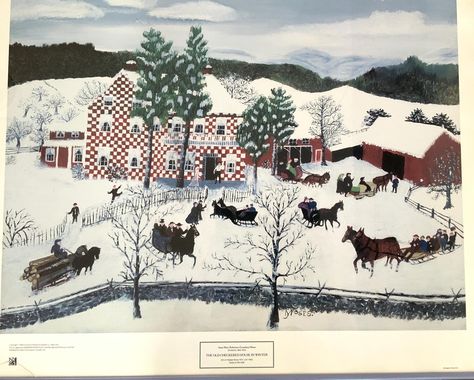Begin with black construction paper and they can draw the window with a ruler like this:
Want to add an element of math to your lesson - here's your chance.
I taught young elementary students so I brought a rectangle of white card stock for them to center on their black paper and trace with white pastel.
Next have them put a green dot just below the top of the window and centered in the middle. Demonstrate making a very small triangle of up and down lines with a dark green pastel. Demonstrate continuing this technique, making the lines longer and wider as they go downward. They will continue to do this until the tree fills up the window and is at the bottom - or almost.
Tell them not to worry if it isn't perfect - nature isn't perfect and the snowstorm will hide any flaws they think they see.
Now add a layer of lighter green lightly over the darker green - leaving some of the darker green visible.
If you have another green, layer that one too - giving the composition depth.
Finally add a yellow green.
The next step is adding red lights and a yellow star to the top.
I told them to add 7 or 8 lights, and to randomly place them on the tree, keeping in mind that there will also be blue and yellow lights. They will have to draw the red on dark to get it to show up over the green. We will add the lighter accents later.
Repeat this step for the blue and the yellow.
To make the lights glow add a little bit of pink, lt. blue, and lt. yellow to the center of the matching lights, and then add a tiny bit of white on top of the lighter colors. The star can look like it's glowing by smudging it with a finger and then redrawing the lines of yellow in the center.
The next step is to do the outside of the house. I chose brown like a log cabin and did stripes, not worrying too much about spacing - it doesn't have to be exact. When I had the first side done I used a ruler to match the other side - see above.
I added another shade of brown and then put a very light shade of grey over that.
Now demo measuring and drawing the window panes on the window with a ruler and white pastel. They will have to go over the green of the tree several times with the white to cover the tree.
Then show them how to do the vertical lines to finish the windowpanes. They will need to outline the window and make it thicker than the window panes inside - they can also add a little drift of snow over the bottom of the window if they like.
The snowstorm is added by doing feather light white pastel lines over the entire composition both horizontally and vertically.
Then they add large and small snowflakes all over until it looks like it's very cold and snowy - and finished!
Brrrrr!!!
This is inspired by a Pin on Pinterest I found, but there weren't any directions. I changed it a little bit.




















































